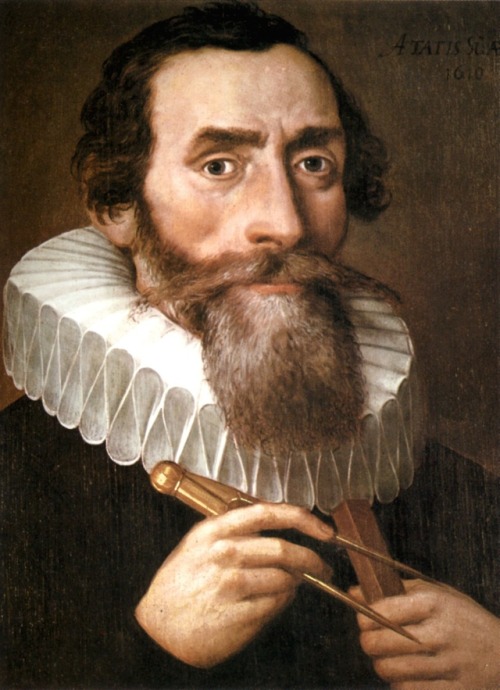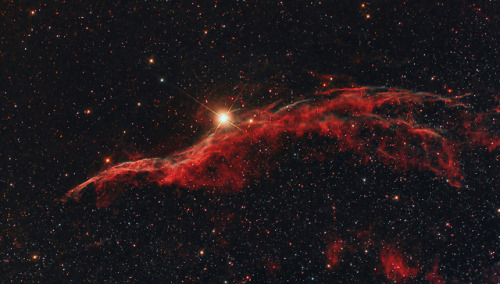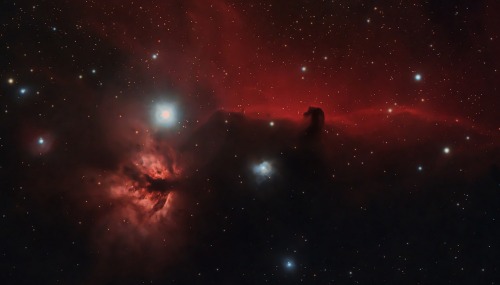Johannes Kepler

Johannes Kepler
Johannes Kepler was a German mathematician, astronomer, and astrologer.
Kepler is a key figure in the 17th-century scientific revolution. He is best known for his laws of planetary motion, based on his works Astronomia nova, Harmonices Mundi, and Epitome of Copernican Astronomy. These works also provided one of the foundations for Isaac Newton’s theory of universal gravitation.
In astronomy, Kepler’s laws of planetary motion are three scientific laws describing the motion of planets around the Sun.
The orbit of a planet is an ellipse with the Sun at one of the two foci.

A line segment joining a planet and the Sun sweeps out equal areas during equal intervals of time.

The square of the orbital period of a planet is proportional to the cube of the semi-major axis of its orbit.

Most planetary orbits are nearly circular, and careful observation and calculation are required in order to establish that they are not perfectly circular. Calculations of the orbit of Mars, whose published values are somewhat suspect, indicated an elliptical orbit. From this, Johannes Kepler inferred that other bodies in the Solar System, including those farther away from the Sun, also have elliptical orbits.
Kepler’s work (published between 1609 and 1619) improved the heliocentric theory of Nicolaus Copernicus, explaining how the planets’ speeds varied, and using elliptical orbits rather than circular orbits with epicycles.
Isaac Newton showed in 1687 that relationships like Kepler’s would apply in the Solar System to a good approximation, as a consequence of his own laws of motion and law of universal gravitation.
Johannes Kepler
Kepler’s laws of planetary motion
More Posts from Carlosalberthreis and Others
O que vamos ter em dezembro de 2017!
What's Up - December 2017
What’s Up For December? Geminid and Ursid meteor showers & winter constellations!

This month hosts the best meteor shower of the year and the brightest stars in familiar constellations.

The Geminds peak on the morning of the 14th, and are active from December 4th through the 17th. The peak lasts for a full 24 hours, meaning more worldwide meteor watchers will get to see this spectacle.

Expect to see up to 120 meteors per hour between midnight and 4 a.m. but only from a dark sky. You’ll see fewer after moonrise at 3:30 a.m. local time.

In the southern hemisphere, you won’t see as many, perhaps 10-20 per hour, because the radiant never rises above the horizon.

Take a moment to enjoy the circle of constellations and their brightest stars around Gemini this month.

Find yellow Capella in the constellation Auriga.

Next-going clockwise–at 1 o'clock find Taurus and bright reddish Aldebaran, plus the Pleiades.

At two, familiar Orion, with red Betelguese, blue-white Rigel, and the three famous belt stars in-between the two.

Next comes Leo, and its white lionhearted star, Regulus at 7 o'clock.

Another familiar constellation Ursa Major completes the view at 9 o'clock.

There’s a second meteor shower in December, the Ursids, radiating from Ursa Minor, the Little Dipper. If December 22nd and the morning of December 23rd are clear where you are, have a look at the Little Dipper’s bowl, and you might see about ten meteors per hour. Watch the full What’s Up for December Video:
There are so many sights to see in the sky. To stay informed, subscribe to our What’s Up video series on Facebook. Make sure to follow us on Tumblr for your regular dose of space: http://nasa.tumblr.com.

Pôr da Lua no Pôr do Sol! 🌙☀️
📅 Data de registro: 5 de agosto de 2024 às 18:23

Pegue carona nessa cauda de cometa! !! Cometa Lovejoy fotografado pelos astronautas da Expedição 30 na ISS

O que está acontecendo com o Sol? Algumas vezes parece que estamos vendo o Sol através de uma lente gignatesca, contudo, na verdade, estamos vendo ele através de milhões de pequenas lentes, os cristais de gelo. A água pode se congelar na atmosfera formando pequenos, achatados cristais de gelo hexagonais. Quando esses cristais flutuam, a maior parte do tempo eles passam com suas faces achatadas e parelelas ao solo. Um observador pode se encontrar no mesmo plano dos cristais de gelo perto do nascer ou do pôr do Sol. Durante esse alinhamento, cada cristal pode agir como uma lente em miniatura, refratando a luz do Sol e criando um fenômeno chamado de parélio, ou sundog. O vídeo acima foi feito a um mês atrás numa região perto de Estocolmo, na Suécia que é uma estação de ski e é conhecida como Vamdalen Ski Resort. Bem no centro está o Sol, enquanto que os proeminentes sundogs brilham à esquerda e à direita dele. Também visível nesse vídeo está o halo de 22 graus, bem como o mais raro e mais apagado, halo de 46 graus, halos esses que também são criados pela reflexão do Sol nos cristais de gelo na atmosfera.
Fonte:
https://apod.nasa.gov/apod/ap180101.html


NGC 6960 (Western Veil nebula) & Horsehead Nebula and the Flame Nebula
by David Wills
Estudar a matéria escura é algo extremamente complicado, começa pelo fato de não sabermos muito bem o que ela é, mas que ela existe, existe.
Uma ideia para estudar a matéria escura é tentar observar o universo na grande escala, numa escala que vai além dos aglomerados de galáxias, por exemplo.
Com observações precisas em escala muito grande, pode-se começar a ter pistas sobre não o que é matéria escura, mas sim como ela se comporta.
Para realizar esse tipo de observação, os astrônomos contam hoje com o VST, o chamado Telescópio de Rastreio do VLT do ESO.
No estudo mais recente para se entender a matéria escura, o VST fez imagens de uma área do céu equivalente a 2200 vezes o tamanho da Lua e contendo cerca de 15 milhões de galáxias.
Ao analisar os resultados, os astrônomos encontraram algo surpreendente, um efeito conhecido como cisalhamento cósmico.
Para esse efeito existir a matéria tem que estar numa escala maior do que a de aglomerados de galáxias.
Basicamente, o cisalhamento cósmico, consiste de uma variante sutil do efeito de lente gravitacional, onde a radiação emitida por galáxias distantes se encontra ligeiramente distorcida pelo efeito gravitacional de enormes quantidade de matéria.
Essa descoberta surpreendeu os pesquisadores, pois isso indica que a matéria escura na rede cósmica é menos irregular, ou menos heterogênea do que se pensava anteriormente.
Esse resultado vai de encontro aos resultados obtidos pelo Planck, que é o observatório espacial que tem como objetivo estudar esse tipo de matéria no universo, de modo que os astrônomos terão que reformular parte do conhecimento sobre como surgiu o universo e como ele evoluiu nesses 14 bilhões de anos.
Além disso esse estudo tem um papel fundamental em entender cada vez mais sobre a matéria escura, que é muito difícil de ser detectada diretamente e sua existência só é inferida a partir do efeito que ela exerce sobre a matéria ordinária do universo.
Os astrônomos esperam que novos telescópios de rastreiam possam pesquisar o céu mais profundo que o VST e que novas missões espaciais possam melhorar os dados do Planck, para que possam compreender, literalmente o que o universo está tentando nos dizer.
(via https://www.youtube.com/watch?v=FADBRclJi4U)
Não sei se vocês sabem, mas a nossa galáxia, a Via Láctea, possui uma estrutura típica.
Podemos dividir a galáxia em:
Disco galáctico - que pode ser dividido em núcleo, bulbo e braços espirais.
Os aglomerados globulares
E o halo.
O halo da Via Láctea, se estende por cerca de 300 mil anos-luz, estima-se que a massa do halo seja comparável à massa de todas as estrelas da Via Láctea.
Embora a estrutura básica da galáxia seja conhecida, existem questões que ainda estavam em aberto, como por exemplo, o fato, de muitos assumirem que o disco da Via Láctea tenha uma rotação, enquanto que o enorme halo de gás seja estacionário.
Porém, pesquisadores usando dados de arquivo obtidos pelo telescópio espacial da ESA, XMM-Newton, mostraram que o reservatório de gás da Via Láctea também tem um movimento de rotação.
Basicamente, os pesquisadores mediram os desvios no comprimento de onda da luz usado linhas de oxigênio muito quente, que são bem registradas pela XMM-Newton.
Esses desvios foram transformados em velocidade, e com isso os pesquisadores descobriram que o halo tem um movimento de rotação na mesma direção do disco e com uma velocidade parecida.
O disco tem uma velocidade de 540000 mph e o halo 400000 mph.
Esse resultado é muito importante, pois ele pode ajudar a entender um grande problema que acontece com a maioria das galáxias, que é sobre a matéria perdida, conhecendo a direção e a velocidade com a qual o halo rotaciona, é possível saber como o material foi parar ali e qual a taxa com que a matéria se estabeleceu ali.
Além disso, a descoberta da rotação do halo galáctico pode fornecer pistas incríveis sobre como se deu a formação da Via Láctea e qual será eventualmente o seu destino.
Ainda mais, essa descoberta pode ser usado para muitos outros tópicos como no desenvolvimento de futuros telescópios espaciais destinados a estudar a emissão de raio-X.
(via https://www.youtube.com/watch?v=3rJJ_G3Vl88)
More Than Just Drawings
Artist and graphic designer Mike Okuda may not be a household name, but you’re more familiar with his work than you know. Okuda’s artistic vision has left a mark here at NASA and on Star Trek. The series debuted 50 years ago in September 1966 and the distinctive lines and shapes of logos and ships that he created have etched their way into the minds of fans and inspired many.
Flight Ops

The Flight Operations patch has a lengthy history, the original version of which dates to the early 1970s. Having designed a version of the patch, Okuda had some insights about the evolution of the design.
“The original version of that emblem was designed around 1972 by Robert McCall and represented Mission Control. It later changed to Mission Operations. I did the 2004 version, incorporating the space station, and reflecting the long-term goals of returning to the Moon, then on to Mars and beyond. I later did a version intended to reflect the new generation of spacecraft that are succeeding the shuttle, and most recently the 2014 version reflecting the merger of Mission Operations with the Astronaut Office under the new banner Flight Operations.”
“The NASA logos and patches are an important part of NASA culture,” Okuda said. “They create a team identity and they focus pride on a mission.”

In July 2009, Okuda received the NASA Exceptional Public Service Medal, which is awarded to those who are not government employees, but have made exceptional contributions to NASA’s mission. Above, Okuda holds one of the mission patches he designed, this one for STS-125, the final servicing mission to the Hubble Space Telescope.
Orion

Among the other patches that Okuda has designed for us, it one for the Orion crew exploration vehicle. Orion is an integral of our Journey to Mars and is an advanced spacecraft that will take our astronauts deeper into the solar system than ever before.
Okuda’s vision of space can be seen in the Star Trek series through his futuristic set designs, a vision that came from his childhood fascination with the space program.
Learn more about Star Trek and NASA.
Make sure to follow us on Tumblr for your regular dose of space: http://nasa.tumblr.com
-
 ellowynthenotking liked this · 8 months ago
ellowynthenotking liked this · 8 months ago -
 ur-not-calling-it-the-enterprise reblogged this · 8 months ago
ur-not-calling-it-the-enterprise reblogged this · 8 months ago -
 bogwitch-extraordinaire reblogged this · 10 months ago
bogwitch-extraordinaire reblogged this · 10 months ago -
 bogwitch-extraordinaire liked this · 10 months ago
bogwitch-extraordinaire liked this · 10 months ago -
 spaceconveyor reblogged this · 10 months ago
spaceconveyor reblogged this · 10 months ago -
 scribe-of-storm reblogged this · 10 months ago
scribe-of-storm reblogged this · 10 months ago -
 heatandapathy reblogged this · 10 months ago
heatandapathy reblogged this · 10 months ago -
 heatandapathy liked this · 10 months ago
heatandapathy liked this · 10 months ago -
 vrinnevi liked this · 10 months ago
vrinnevi liked this · 10 months ago -
 fr0ggycha1rs liked this · 10 months ago
fr0ggycha1rs liked this · 10 months ago -
 quiggsy reblogged this · 10 months ago
quiggsy reblogged this · 10 months ago -
 quiggsy liked this · 10 months ago
quiggsy liked this · 10 months ago -
 starrshot liked this · 10 months ago
starrshot liked this · 10 months ago -
 tano-italiano reblogged this · 10 months ago
tano-italiano reblogged this · 10 months ago -
 tano-italiano liked this · 10 months ago
tano-italiano liked this · 10 months ago -
 thefreakinggeneral liked this · 10 months ago
thefreakinggeneral liked this · 10 months ago -
 pass-the-boof-please reblogged this · 10 months ago
pass-the-boof-please reblogged this · 10 months ago -
 pass-the-boof-please liked this · 10 months ago
pass-the-boof-please liked this · 10 months ago -
 beardedmrbean reblogged this · 10 months ago
beardedmrbean reblogged this · 10 months ago -
 gregorlenko liked this · 10 months ago
gregorlenko liked this · 10 months ago -
 tthel liked this · 10 months ago
tthel liked this · 10 months ago -
 info-of-all-kinds reblogged this · 10 months ago
info-of-all-kinds reblogged this · 10 months ago -
 thesolitarycat liked this · 10 months ago
thesolitarycat liked this · 10 months ago -
 wasserturm6 liked this · 10 months ago
wasserturm6 liked this · 10 months ago -
 vulpecula11blr liked this · 10 months ago
vulpecula11blr liked this · 10 months ago -
 chasedbybuildings liked this · 10 months ago
chasedbybuildings liked this · 10 months ago -
 vicariouslee liked this · 10 months ago
vicariouslee liked this · 10 months ago -
 jeraliey reblogged this · 10 months ago
jeraliey reblogged this · 10 months ago -
 nitzeart liked this · 10 months ago
nitzeart liked this · 10 months ago -
 thefinestwaifu reblogged this · 10 months ago
thefinestwaifu reblogged this · 10 months ago -
 thefinestwaifu liked this · 10 months ago
thefinestwaifu liked this · 10 months ago -
 totallyasexual liked this · 10 months ago
totallyasexual liked this · 10 months ago -
 anonymouskitty27 reblogged this · 10 months ago
anonymouskitty27 reblogged this · 10 months ago -
 crystalstarstuff liked this · 10 months ago
crystalstarstuff liked this · 10 months ago -
 kmlaney liked this · 10 months ago
kmlaney liked this · 10 months ago -
 tachvintlogic reblogged this · 10 months ago
tachvintlogic reblogged this · 10 months ago -
 empressxmachina liked this · 10 months ago
empressxmachina liked this · 10 months ago -
 maxi-dus liked this · 10 months ago
maxi-dus liked this · 10 months ago -
 qwerkyworkings reblogged this · 10 months ago
qwerkyworkings reblogged this · 10 months ago -
 a-littlebeauty liked this · 10 months ago
a-littlebeauty liked this · 10 months ago -
 celestial-ceremony reblogged this · 10 months ago
celestial-ceremony reblogged this · 10 months ago -
 celestial-ceremony liked this · 10 months ago
celestial-ceremony liked this · 10 months ago -
 zippocreed501 liked this · 10 months ago
zippocreed501 liked this · 10 months ago -
 beelper-owo liked this · 10 months ago
beelper-owo liked this · 10 months ago -
 gayingupspace reblogged this · 10 months ago
gayingupspace reblogged this · 10 months ago -
 r3dg0ld-black liked this · 10 months ago
r3dg0ld-black liked this · 10 months ago


